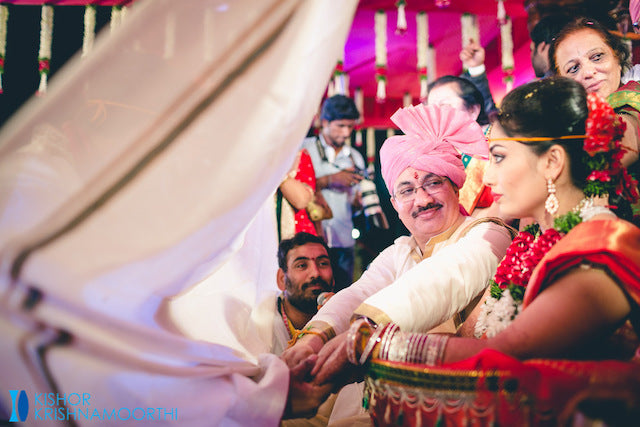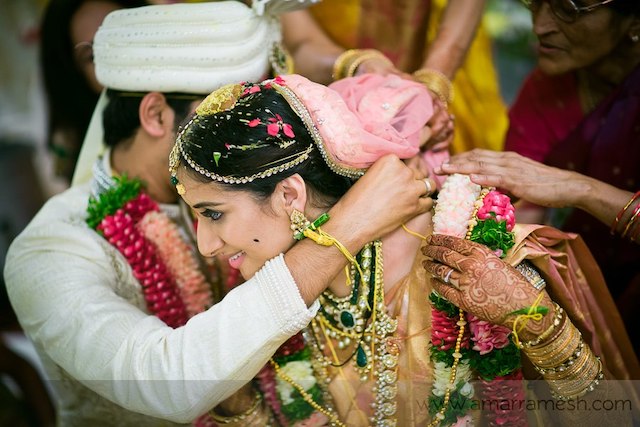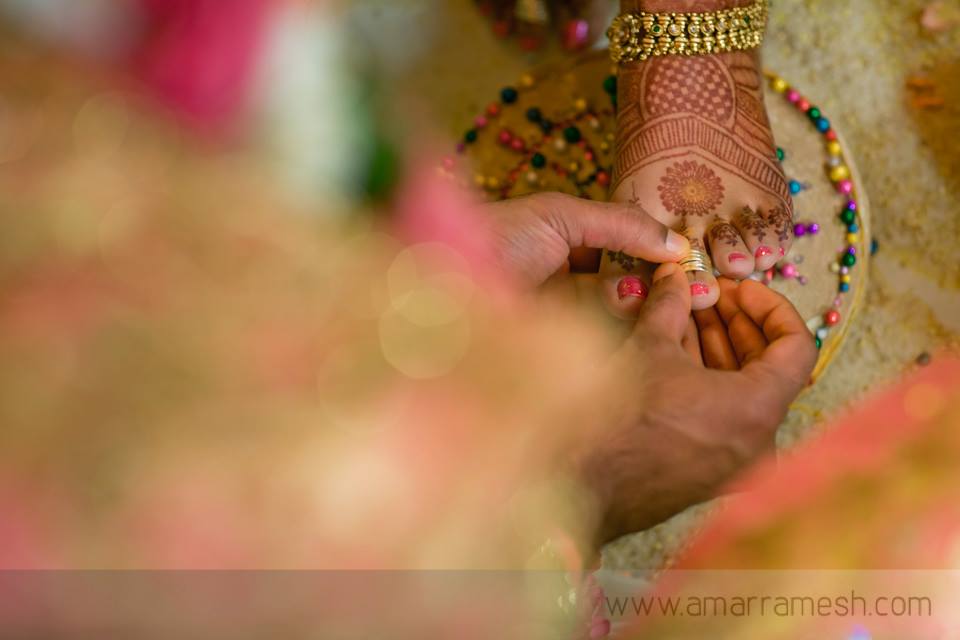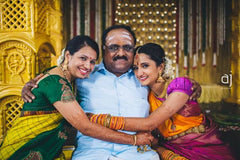
Telugu Wedding Diary!
Telugu weddings are known for their colour, fun and grandeur! The typical Telugu wedding goes on for a few days and is packed with yards of fun and culture. Be it any wedding, the participation and enthusiasm of the family matters the most and you can easily experience that in a Telugu wedding. 
 The first pre-wedding function begins with Muhurtham. Surrounded by a priest and the elders of both the families, an auspicious date is hand-picked after measuring all astrological and religious indices. The next in line is called the Haldi ceremony or the Pendikoothuru. Smearing the bride and groom to be with yellow turmeric paste and giving them a good oil baste for purification. It goes without saying that immediately following this, the girl and boy are presented with a new saree and dhoti respectively.
The first pre-wedding function begins with Muhurtham. Surrounded by a priest and the elders of both the families, an auspicious date is hand-picked after measuring all astrological and religious indices. The next in line is called the Haldi ceremony or the Pendikoothuru. Smearing the bride and groom to be with yellow turmeric paste and giving them a good oil baste for purification. It goes without saying that immediately following this, the girl and boy are presented with a new saree and dhoti respectively.






 The typical Telugu wedding happens after sunset. So before making their way to the Mandap/Temple, the soon-to-be missus is required to make a quick prayer called the Gauri puja while the groom is supposed to offer similar prayers to Lord Ganesha. This is to ward off all the evils, obstacles and to receive blessings for their holy union.
The typical Telugu wedding happens after sunset. So before making their way to the Mandap/Temple, the soon-to-be missus is required to make a quick prayer called the Gauri puja while the groom is supposed to offer similar prayers to Lord Ganesha. This is to ward off all the evils, obstacles and to receive blessings for their holy union.  Traditionally, Telugu weddings were conducted in a temple but lately, marriage halls and hotel banquets work just fine in creating a perfect ambience. The flower and mango leaves ornately strung in different colours do their job well in adding to that.
Traditionally, Telugu weddings were conducted in a temple but lately, marriage halls and hotel banquets work just fine in creating a perfect ambience. The flower and mango leaves ornately strung in different colours do their job well in adding to that.



After all pre-wedding shivers have been shed, the bride is then escorted to the hall usually by a maternal uncle mostly in a basket or pallakku or even walk in with a intricately designed canopies and the stage for the proceedings is set with upholstered flowers twined prettily. 



The newly arrived groom and bride actively partake in rubbing cumin - tamarind paste onto each other�s heads to signify a bond that is to be inseparable. This ritual is called Jeelakarra Bellam. 


Now all that�s left is for the girl�s parents is to officially give their daughter away to her husband. This ritual is called Kanyadhaan and the parents wash the groom�s feet offering their daughter�s hands. The obliging grooms promise to love and respect their bride in return. Now is when the bride makes the final transformation. From the regular silk she wears, she is then carted off to the dressing room to don her final bridal saree. Most of them wear the white and red combination that stands for the purity and strength embedded into the promise of holy matrimony. 



Oh, it is important to mention that all this while, the bride and groom although seated together were separated by a curtain. It is only now that the curtain is removed and they finally see each other in all their wedding-glow. The groom is handed the Mangalsutra, a yellow thread which is the awaited moment of the whole ceremony. He ties 3 knots of the Mangalsutra around the bride symbolizing their physical, mental and spiritual union. 


 Fishing the ring is where the fun part of the wedding lies. While the couple look for a ring in the pot, the families cheer them up and enjoy the game just like the couple.
Fishing the ring is where the fun part of the wedding lies. While the couple look for a ring in the pot, the families cheer them up and enjoy the game just like the couple. 


Then comes Talambralu where the bride and groom take turns to pour on each other�a handful of yellow rice or pearls mixed with saffron while a priest recites the mantras. 




They exchange garlands while everyone showers the new couple with yellow rice or akshada in blessing and watch them walk around the fire seven times as man and wife. This is called the Saptapadi or Sthaalipaakam. After they make their promises, the new husband puts a silver ring on the bride�s toe officiating an end to all the wedding ceremonies. 


 The wedding ends with the usual set of events like Arundathi natchatram, vidai and finally the gruhapravesh, where the bride enters her new home!
The wedding ends with the usual set of events like Arundathi natchatram, vidai and finally the gruhapravesh, where the bride enters her new home! 



 Although many in number, each of the ceremony is encrusted with heavy spiritual reasons and beliefs noticed in most Hindu weddings. A window into a telugu wedding tale tells us this, that marriages although manifold in its layers, can be a lot of fun. After all, it is a chance to meet your near and dear ones, a sort of coming together to watch new bonds forge.
Although many in number, each of the ceremony is encrusted with heavy spiritual reasons and beliefs noticed in most Hindu weddings. A window into a telugu wedding tale tells us this, that marriages although manifold in its layers, can be a lot of fun. After all, it is a chance to meet your near and dear ones, a sort of coming together to watch new bonds forge. 









